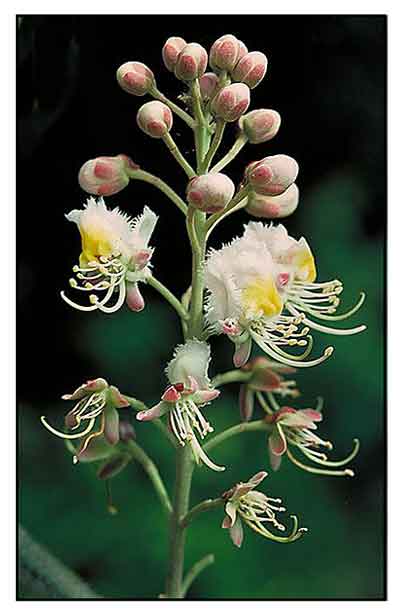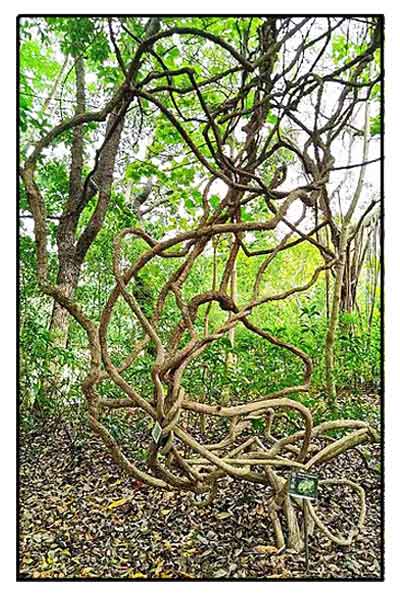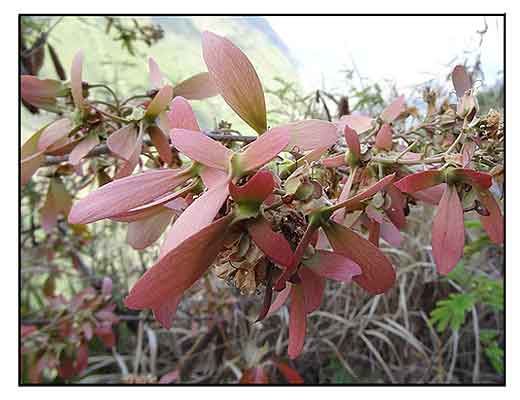 Gen info Gen info
-
Etymology: Genus name Hiptage derives from Greek hitamai, meaning "to fly", referring to its unique three-winged fruit known as "samara". Benghalensis is derived from the historic region of Bengal, where it is a native species.
- "Helicopter flower" name refers to the shape of the flowers, like three blades of a helicopter fan.
Botany
Hiptage benghalensis is a perennial, woody, much-branched, evergreen, vine-like shrub that can reach a height of 10-15 m. Young branches are gray and tomentose. The leaves are simple, entire, opposite, oblong to ovate-lanceolate, 8-21 cm long and 4-9 cm wide, acute or acuminate, glabrous, a red-varnished color when young and have petioles about 1 cm long. The highly fragrant, pink to white flowers have a yellow throat, are strongly zygomorphic, 2-3 cm in diameter, borne in erect, pubescent, axillary racemes of 10-20 cm length, the pedicels being 15-20 mm long. The corolla has five free, elliptic to round, pubescent, reflexed petals 1-1.7 cm long, fringed on the margins. Fruits are samaras with three spreading, papery, oblanceolate to elliptic wings, the middle wing being 4-6 cm long and the two lateral wings 2-3 cm long. Dry fruits are propelled by wind to places where the seeds are released. (3)
Distribution
- Native to the Philippines.
- Cultivated for its attractive, fragrant flowers.
- Also native to Andaman Is, Assam, Bangladesh, Borneo, Cambodia, China, Hainan, Himalaya, India, Jawa, Laos, Lesser Sunda Is., Malaya, Myanmar, Nepal, Nicobar Is., Pakistan, Sri Lanka, Sulawesi, Sumatera, Taiwan, Thailand, Vietnam.
(1)
- Grows primarily in the wet tropical biome.
- Introduced as an ornamental, it is now naturalized in tropical areas with continuing increase in its distribution.
- The climbing vine has spread and has shown ability to smother vegetation and produce wind-dispersed samaras to facilitate dissemination. It threatens lowland native forests in La Réunion and Mauritius and is invasive in parts of Australia, Hawaii and Florida, where it is regulated. (3)
 Constituents Constituents
- Qualitative phytochemical screening of ethanol extract of stem yielded steroid, carbohydrate, flavonoid, alkaloid, tannins, phenol, mangiferin and terpenoids. (see study below) (4)
- Study of chloroform-soluble fraction of stem bark isolated seven triterpenes and a steroid derivative, characterized as alnus-5(10)-en-3β-yl acetate (1), oleanan-3-one (2), 3β-acetoxy-9β-bauer-7-en-6-one (3), lupeol (4), (24R)-24-propylcholesterol (5), alnus-5(10)-en-3β-ol (6), 3β-acetoxy-20-hydroxylupane
(7), and betulonic acid (8) by spectroscopic methods. (see study below) (5)
- Methanol leaf and stem bark extract revealed the presence of alkaloids, anthraquinones, catechin, coumarin, flavonoids, phenols, sterols, tannins, terpenoids, and xanthoprotein. (see study below)
(19)
Properties
- Studies have suggest antibacterial, analgesic, anti-inflammatory, antidiabetic, hepatoprotective, anticancer, insecticidal, antidiabetic, anthelmintic, anti-asthma, hepatoprotective properties
Parts used
Bark, stem, leaves, flowers.
 Uses Uses
Folkloric
- In Lesser Sunda Islands, the bark is pounded and applied to fresh wounds. In Thailand, the wood is an appetizer and considered antiflatulent, carminative, and aphrodisiac; believed to relieve fatigue and to promote longevity. (2)
- In Vietnam, wood is used to relieve fatigue and treat nocturnal emission of sperm. In India, leaves used for cutaneous diseases. (2)
- Leaf juice used to treat scabies. Plant also sued for rheumatism and asthma.
(2)
- According to Ayurveda, the plant is cooling, vulnerary, astringent, expectorant, cardiotonic, anti-inflammatory, insecticidal, wound healing, antipruritic, and used in scabies, leprosy, skin diseases, cough, asthma, cardiac debility, obesity, etc. (8)
- In Bangladesh, flowers and roots used for treatment of diabetes and colds.
(14)
- In Assam, juice of flower used for ear pain. (17)
- The Kanikkars of Western Ghats apply paste of leaves and flowers twice daily for treatment of ringworm infection. (22)
Others
- Insecticidal: Leaf juice considered insecticidal. (see study below-10)
 Studies Studies
• Antidiabetic / Stem: Study evaluated the phytochemicals and antidiabetic activity of stem of Hiptage benghalensis in rats. The extract exhibited dose-dependent inhibition of glucose absorption and hypoglycemic effects in Long-Evans rats. (see constituents above) (4)
• Anti-Inflammatory / Stem Bark: Study of chloroform-soluble fraction of stem bark isolated seven triterpenes and a steroid derivative. Compounds 1, 2, 5, 6, 7, and 8 showed significant in vitro anti-inflammatory activity via inhibition of production of NO and PGE2 and protein expressions of iNOS and COX-2 in LPS-stimulated RAW 264.7 macrophages. Compounds 1, 2, 7, and 8 also significantly increased protein expression of IkBα, and decreased protein expression of p-p65 and transcriptional activity of NF-kB in LPS-stimulated RAW 264.7 macrophages. (see constituents above) (5)
• Antimicrobial / Root Bark: Study evaluated a methanol extract of root bark of H. benghalensis for antimicrobial activity using disc diffusion method. Results showed significant activity at low concentrations, 0.625 mg/ml on Klebsiella pneumonia, Micrococcus luteus, and Pseudomonas aeruginosa, and 0.3125 mg/ml on Escherichia coli. (6)
• Anticancer Against Various Cancer Cell Lines: Study evaluated the anticancer effects of methanolic extract of Hiptage benghalensis against various human cancer cell cultures viz. human cervical carcinoma (HeLa) cells, human breast cancer (MCF-7) cells, and human neuroblastoma (MR-32) cells. Results showed dose-dependent inhibition in all types of cancer cells using MTT assay. Extract concentration causing 50% cell deaths were 50.73, 47.90, and 53.76 µg/mL against HeLa, MCF-7, and IMR-32, respectively. (7)
 • Analgesic / Anti-Inflammatory: Study evaluated the analgesic and anti-inflammatory activities of ethanol extract of H. benghalensis. The extract showed statistically significant (p<0.05) anti-inflammatory effect in Carrageenan-induced Hind Paw Edema test in Long Evans rats and significant analgesic response to Hot Plate and Acetic Acid induced writhing in Swiss albino mice. (9) • Analgesic / Anti-Inflammatory: Study evaluated the analgesic and anti-inflammatory activities of ethanol extract of H. benghalensis. The extract showed statistically significant (p<0.05) anti-inflammatory effect in Carrageenan-induced Hind Paw Edema test in Long Evans rats and significant analgesic response to Hot Plate and Acetic Acid induced writhing in Swiss albino mice. (9)
• Insecticidal / Repellent Against Mosquito Vectors / Root Bark: Study evaluated the larvicidal, adulticidal, and repellent activities of acetone root bark extract of Hiptage benghalensis against larvae and adults of three mosquito vectors viz., Anopheles barbirostris, Culex quinquefasciatus, and Aedes albopictus, which are primary vectors of malaria, lymphatic filariasis, and dengues, respectively. H. benghalensis was more effective as larvicides. Regression analysis showed LC50 values gradually decreased with exposure periods; lethal time (LT50) decreased with concentration, and mortality positively correlated with concentration. Order of susceptibility was A. albopictus > A. barbirostris > C. quinquefasciatus. Results suggest potential as potent larvicide and control of the mosquito species on its breeding site. (10)
• Antidiabetic in STZ-Induced Rats: Study evaluated the effect of H. benghalensis on glycemia, lipid profile, lipoprotein level, and antioxidant profile in STZ induced diabetic rats for 21 days. Results showed improvement in lipid level and lipoprotein level. Levels of urea and creatinine significantly decreased after treatment with the extract. There was amelioration of changes induced by STZ. (11)
• Anti-Asthmatic / Oral Formulations / Leaves: Study evaluated herbal oral formulations (tablets and syrups) and dry powder of ethanolic extract of leaves of H. benghalensis used to treat asthma in animal models. Formulated dosage forms showed significant protection from histamine and Ach induced bronchospasm when compared to control group and is comparable to crude extract of H. benghalensis and marketed anti-asthmatic product. (12)
• Anthelmintic / Leaves: Study evaluated aqueous and ethanolic extract of leaves for anthelmintic activity using concentrations of 5, 10, and 25 mg/ml, measuring time of paralysis and time of death of earthworm Pheretima posthuma. The aqueous extract showed more potent activity when compared with standard drug Piperazine citrate. (13)
• Antidiabetic / Stem: Study evaluated the antidiabetic activity of ethanolic extract of H. benghalensis stem in STZ induced diabetic rats. Acute oral toxicity study of EE showed a 2000 mg/kg dose was non toxic and safe. The extract at doses of 100 and 200 mg/kbw was found to reduced blood glucose level Extract treated group showed increase in HDL and protein values, and reduced VLCL, TC, and TG. (15)
• Biodiesel / Seeds: Study evaluated the production of diesel from bio-oils derived from plant biomass as potential source. Hiptage benghalensis is an unexplored plant that stores ricinoleic acid in its seeds. Seeds from three locations yielded total lipid and ricinoleic acid contents from 54-69% and 69-87%, respectively. Properties showed its potential as a biodiesel feedstock. The seed oil was converted into biodiesel through transesterification with an efficiency of about 93%. Fuel properties like acid value, calorific value, viscosity, density, ash content, flash, pour and cloud point showed reasonable quality. Results suggest potential to alternate green energy source for biodiesel production. (16)
• Analgesic / Anti-Inflammatory / Leaves: Study evaluated a methanolic extract of leaves for analgesic (using hot plate test and acetic acid-induced writhing test in mice) and anti-inflammatory (using rat paw edema test) activity at doses of 200 and 400 mg/kbw. Results showed significant analgesic and anti-inflammatory effects, which were comparable with standard drugs. (18)
• Antibacterial / Leaves and Stem Bark: Study evaluated the antibacterial activity of Bauhinia purpurea and Hiptage benghalensis against various test pathogens by disc diffusion method. The petroleum ether leaf extract of H. benghalensis showed antibacterial activity against S. aureus, B. subtilis, P. aeruginosa, and S. typhi, while stem bark extract showed activity against K. pneumonia, E. coli, and S. typhi. Chloroform leaf extract showed activity against S. aureus, K. pneumonia, E. coli, P. aeruginosa and S. typhi. The methanol extracts of leaf and stem bark showed activity against all tested pathogenic bacteria. Activity was comparable to tetracycline and chloramphenicol. (see constituents above) (19)
• Hepatoprotective / Carbon Tetrachloride Toxicity / Leaves: A methanolic leaves extract of Hiptage benghalensis showed hepatoprotective activity in rats against carbon tetrachloride-induced liver damage that was comparable to standard medication silymarin (50 mg/kg). (20)
• Genes Associated with Ricinoleic Acid Accumulation / Transcription Analysis: Ricinoleic acid is a high-value hydroxy fatty acid with broad industrial applications. Hiptage benghalensis seed oil contains a high amount of ricinoleic acid (~ 80%) and is an emerging source of this unusual fatty acid. Study evaluated the molecular mechanism of ricinoleic acid biosynthesis and regulation. Gene transcription profiles of developing seeds revealed 12 genes involved in diverse lipid metabolism pathways displayed high expression levels and consistent expression patterns with ricinoleic accumulation in developing seeds, suggesting their primary roles in ricinoleic production. Study identified a pool of novel genes regulating ricinoleic acid accumulation, setting a foundation for developing H. benghalensis into a novel ricinoleic acid feedstock at the transcriptomic level and provided valuable candidate genes for improving ricinoleic acid production in other plants. (21)
Availability
Wild-crafted.
Cultivated.
|

![]()




 Constituents
Constituents Uses
Uses  Studies
Studies  • Analgesic / Anti-Inflammatory: Study evaluated the analgesic and anti-inflammatory activities of ethanol extract of H. benghalensis. The extract showed statistically significant (p<0.05) anti-inflammatory effect in Carrageenan-induced Hind Paw Edema test in Long Evans rats and significant analgesic response to Hot Plate and Acetic Acid induced writhing in Swiss albino mice. (
• Analgesic / Anti-Inflammatory: Study evaluated the analgesic and anti-inflammatory activities of ethanol extract of H. benghalensis. The extract showed statistically significant (p<0.05) anti-inflammatory effect in Carrageenan-induced Hind Paw Edema test in Long Evans rats and significant analgesic response to Hot Plate and Acetic Acid induced writhing in Swiss albino mice. (